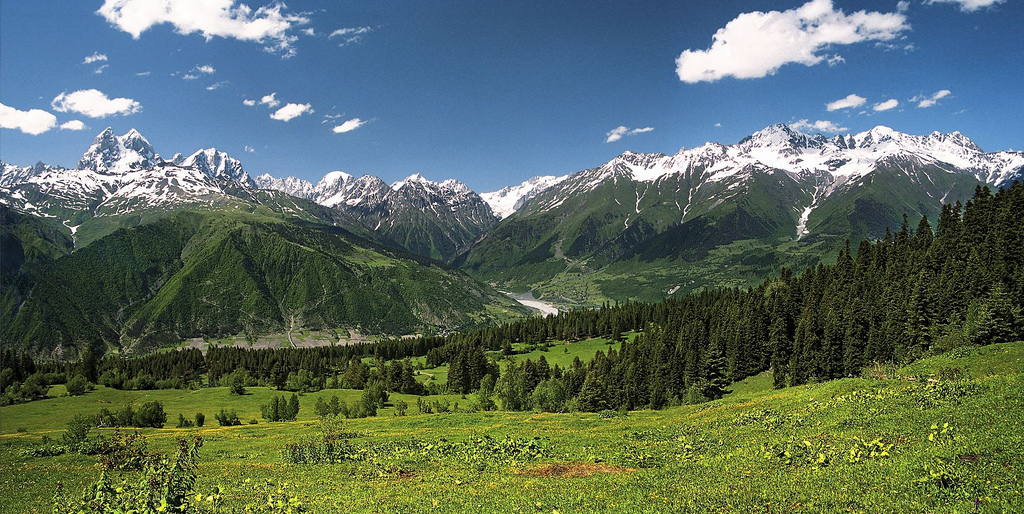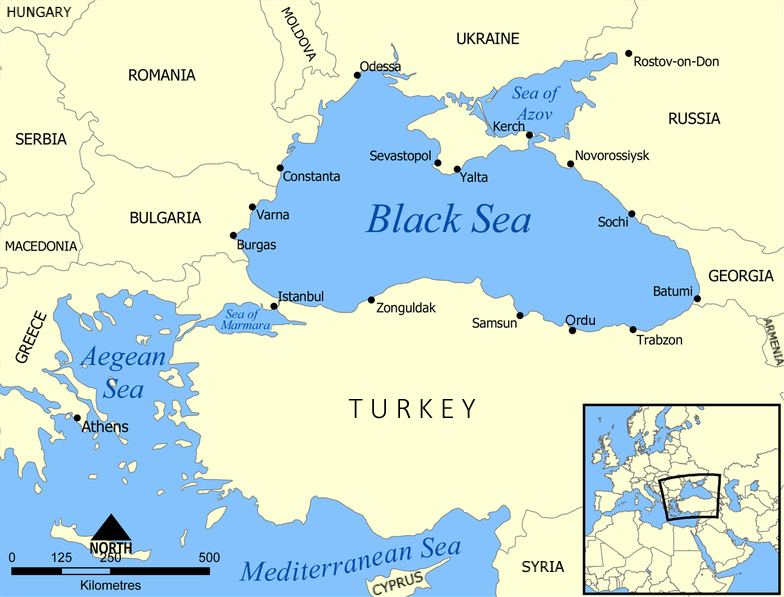I. Introduction
According to researchers who have studied it closely, the tidal area in AJ.SE.NW, the Black Sea, was not always tidal (
Black Sea Commission).
It was land locked until the sea level rose above a low valley-like area near Istanbul, Turkey.
The rising Mediterranean waters caused the Aegean Sea near Athens, Greece to also rise, which in turn caused the Sea of Marmara waters to rise, and then to eventually flow together to join with the Black Sea waters.
Since the time that sea level rise caused by ancient Ice Age melt brought the bodies of water together, the narrow strait that was formed has, in modern times, been the focus of international involvement (
Turkish Straits,
Montreux Convention).
The fact that a narrow strait was formed by natural sea level rise is interesting for several reasons.
But, it can't be completely envisioned and appreciated unless you take a close look.
In
Fig. 2 (click to enlarge) you can see ships near the southern entrance, in the Sea of Marmara, about to enter the Turkish Straits.
Those vessels are on a northward heading which eventually takes them through the polluted water of the straits to the waters of the Black Sea (
Fig. 2).
Note, for a better understanding of some of the rest of this post, that those waters are flowing from the Black Sea into the Sea of Marmara, then on into the Aegean, and finally into the Mediterranean.
II. How This Post Arose
I was running a module, in the
Dredd Blog sea level change software model, which calculates and then writes
CSV files which are used for generating graphs.
 |
| Fig. 3 |
Regular readers know that the modules that I am talking about access
PSMSL data stored in an SQL database that I downloaded from the PSMSL organization.
Anyway, the module was analyzing the data zone by zone, and printing out a log of what it did, in addition to writing the CSV files.
It printed out 204 CSV files, one for each valid sub-quadrant in the database.
Let/s take a look at the first, last, as well as the one that caught my eye:
1) AA.SW.NW: from 1950 through 2002, 3 PSMSL stations recorded 53 years of SLC data. Changes (mm): [max=106.938, min=-130.666].
...
66) AJ.SE.NW: from 1874 through 2014, 6 PSMSL stations recorded 141 years of SLC data. Changes (mm): [max=1249.41, min=0].
...
204) A9.SE.NE: from 2001 through 2009, 1 PSMSL station recorded 8 years of SLC data. Changes (mm): [max=75.165, min=0].
That is the largest zone mean sea level rise (1,249.41 mm) I have yet discovered in the PSMSL system.
It is (1249.41 ÷ 304.8 =) 4.1 feet of sea level rise in 141 years.
That is an average of 8.86 mm per year for 141 years.
III. The PSMSL Stations In AJ.SE.NW
You can look-up the stations involved by clicking on the following PSMSL links to the pages of the 6 tide gauge stations in sub-quadrant AJ.SE.NW:
#41 POTI; #51, BATUMI; #215, TUAPSE; #1927, TRABZON II; #1919, AMASRA; and #42, SEVASTOPOL.
Only one of them is marked as having some questionable data (
#51, BATUMI).
IV. The Reason For The High Sea Level Rise
There are a number of high-volume rivers which flow into the Black Sea area, but the strait (
Fig. 2) is not large enough to allow an equal outflow:
"The resistance of the straits prevents the immediate export of the excess water coming from rivers and air – sea exchange, thus the response to external forcing is amplified, making the signals quite distinct both in the tide gauge data (Simonov and Altman, 1991; Boguslavsky et al., 1998), as well as in the satellite altimetry (Korotaev et al., 1998, 2001; Stanev et al., 2000). The control of the Bosphorus Straits makes the Black Sea a good overall integrator of the various kind of forcing and internal variability and maintains a strong correlation between the fresh water fluxes and sea level variability (Stanev et al., 2000)."
(
Black Sea Variations). Thus, unless there are melting glaciers and/or ice sheets still feeding those rivers, this is an example of natural, non-anthropogenic sea level rise.
Historically, glaciers have been a source of melt water which has had an impact on the sea level of the Black Sea:
As the supply of the melting water from the glaciers through the Dniepr and the Dniestr rivers, as well as the Danube river to the Black Sea was very direct and important, the Neoeuxinian sea-level rose very quickly, reaching and overpassing at ~ 12 ka BP the Bosphorous sill altitude. The majority of scientists, who studied the Black Sea, believe that in this phase it was a large fresh-water outflow through the Bosphorous-Dardanelles straits towards the Mediterranean (Aegean) Sea. Kvasov (1975) calculated that the fresh water outflow discharge was of about 190 km3/year.
At the beginning of the Holocene, some 9-7.5 ka BP, when the Mediterranean and the Black Seas have reached the same level (close to the present day one), the two-way water exchange was established, and the process of transformation of the Black Sea in an anoxic brackish sea started. During the last 3 ka BP, a number of smaller oscillations of the water level have been recorded (“Phanagorian regression”, “Nymphaean” transgression, a lowering of 1÷2 m in the X-th century AD, a slow rising continuing even today).
(
The Black Sea, p. 4, PDF). Evidently the flow of glacial melt water through the rivers that empty into the Black Sea has now stopped.
Thus, in that sense the sea level rise in the AJ.SE.NW sub-quadrant is not caused by anthropogenic global warming.
Nevertheless, one could argue that to the extent that the Mediterranean has had sea level rise at or near the Turkish strait, it could be increasingly blocking the outflow from the Black Sea.
In that case there would be an indirect global warming affect to the Black Sea area's sea level rise shown in
Fig. 3.
V. Climate Change Research About The Black Sea
A regular reader, Randy, wondered about precipitation in the watersheds of rivers discharging into the Black Sea.
Here is some information on that issue:
"The detection of trends requires the availability of long-term time series of river discharge. Unfortunately, the release of hydrological data from national monitoring networks is not as common as for climate data. This is particularly true in the Mediterranean context, where water resources represent an important economical value and political barriers probably still inhibit more transparency on river data.
...
The Danube and the Dniepr are the only rivers where the records extend to recent years, whereas the other records stop already in 1984. This complicates the detection of long-term trends. Nevertheless, it seems that the general trend towards decreasing water discharge of the Mediterranean rivers is absent in the Black Sea.
...
For the Black Sea rivers ... climate is characterized by a continental precipitation regime, and summer precipitation can even exceed precipitation in winter (Ludwig et al., 2003). This sharply contrasts with the Mediterranean climate."
(
Water discharge Black Sea, pp. 203-06). At first blush, one would think that discharge into the Black Sea from the Danube and Dniepr (the two most significant discharge contributors to the Black Sea) would have an upward trend line.
However, the paper goes on to assert:
Over the 1960–2000 period, river freshwater discharge to the Mediterranean Sea decreased, while that to the Black Sea remained more or less constant. For the former, we estimate the reduction to be at least 20% ... This reduction is mainly derived from the large-scale evolution of precipitation and temperature and thus reflects the potential impact of climate change on river freshwater discharge.
(
ibid, p.214). The Mediterranean Sea lost 20% of discharge volume due to climate change, while the Black Sea held "more or less constant" by comparison.
I think they summed it up well:
"Further work including new data and modelling is clearly needed to define if this may have also occurred at other places. Modelling studies are also needed to evaluate the potential impact of the reductions in freshwater inputs on marine ecosystems through modifications of the water circulation in the Mediterranean Sea."
(
ibid, p. 215). To which I would add, "yes, and that should be done by reference to sea level change records as I have done."
Then it becomes obvious, since the Black Sea has risen 4.1 feet, that the "more or less constant" statement should be "the Black Sea is rising a lot, and is doing so quickly."
Further, silting, land subsidence, thermal expansion and the like, do not explain the steep sea level rise.
I demand that those governments that are holding back the data as the paper indicated ("
Unfortunately, the release of hydrological data from national monitoring networks is not as common as for climate data") change their policy and let the scientists use that data.
VI. The Black Sea Phenomenon is Useful
A PSMSL station in the area shows that sea level rise near the entrance to the strait shown in
Fig. 2: has increased.
Sea level at Stn
#1598, ERDEK (Aegean, Mediteranean) increased by about 1.3 ft from 1984 – 2009.
Thus, IMO the "plugging of the drain" effect at the strait can be attributed in part to indirect anthropogenic global warming, because of the sea level rise global warming there generates.
But, by and large, even though to some degree the Black Sea is experiencing sea level rise because there is a natural blockage, one useful thing to be gained by it all is that
it is a case in point for what will happen during future anthropogenic sea level rise in other areas.
(cf.
Danube Watershed,
Danube Watch,
Danube Watershed History (2005),
Danube Watershed History (2014).
VII. Conclusion
The Black Sea phenomenon is known to port officials.
The officials and mentors for port construction and operations are also aware of what sea level science portends:
For new terminals, building quays higher is an obvious measure – ‘but it is still based on broad assumptions, unless there are site specific studies’. Also, deeper water generates larger waves. “You should allow for the increased impact of water levels on wave breaking – maybe breakwater designs need looking at.
“And even if you can afford a new port and design the level accordingly, the hinterland behind it and all the connections are still vulnerable. Assuming that your connections might be inundated, then you are going to need larger storage areas to hold containers, etc., and I don’t think that’s typically factored in.”
Ben Lieberman, senior port planner at US-based consultants Louis Berger, agrees: “It is known that sea levels are rising but nobody knows how much how fast. There are models to predict, but there is a margin of error. So does another metre (quay height) give you some assurance? It puts you in better shape, but you would have to do an analysis of what it would cost to raise it in terms of concrete, piles, etc. However, it is of course easier to design it in the beginning than go back and retrofit.”
How much attention is being paid to climate change issues in port design? It can’t be avoided in new developments, says Mr Lieberman, because the banks or others providing the finance will insist on adequate consideration of such issues.
“Whether it is addressed effectively is another matter – because we don’t know ‘how much’. And if you are talking about the modification of existing facilities, then obviously you are constrained by the existing design.”
(
Port Strategy). It is time for the business as usual sea level scientists to realize that they may be seen, in the future, as being responsible for very costly and confusing rhetoric.
"Worse than previously thought" is an overused but real phrase we read about often.
Time to replace it with "thanks for thinking ahead for us."





